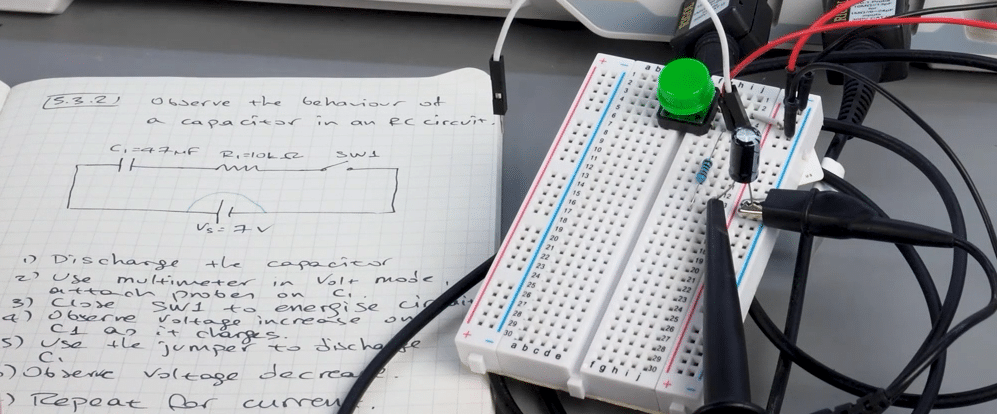ELECTRONICS guide series
Introduction to Electronics Direct Current (DC) and Alternating Current (AC) circuits
This guide will help you understand electronic circuits—the fundamental building blocks of modern technology. Electronics are all around us, embedded in countless devices we use daily, and it all starts with these circuits.

Direct Current (DC) and Alternating Current (AC) circuits
Direct Current (DC) and Alternating Current (AC) are two types of electrical current used in circuits. The primary difference between them lies in the direction in which the electric charge flows. In a DC circuit, the electric charge flows in a single, constant direction. This type of current is typically produced by sources such as batteries and solar cells. DC is commonly used in low-voltage applications like electronic devices and automotive systems.
In contrast, AC circuits have electric charges that periodically reverse direction. This alternating nature of the current is characterized by its frequency, measured in Hertz (Hz). In most countries, the standard frequency of AC power supply is either 50 Hz or 60 Hz. AC is generated by power plants and is the form of electricity delivered to homes and businesses via the power grid. The ability of AC to be easily transformed to different voltages using transformers makes it more suitable for long-distance transmission, reducing energy losses.
This table highlights the key differences and similarities between Direct Current (DC) and Alternating Current (AC) circuits:
| Feature | Direct Current (DC) | Alternating Current (AC) |
|---|---|---|
| Definition | Unidirectional flow of electric charge | Bidirectional flow of electric charge |
| Direction of Current | Flows in one constant direction | Changes direction periodically |
| Voltage | Constant | Varies sinusoidally with time |
| Frequency | Zero (0 Hz) | Typically 50 or 60 Hz |
| Source | Batteries, DC power supplies | Power plants, AC generators |
| Applications | Electronic devices, automotive systems | Household appliances, industrial equipment |
| Transmission | Inefficient for long distances due to higher energy losses | Efficient for long-distance transmission |
| Waveform | Straight line (constant value) | Sinusoidal wave |
| Conversion | Requires inverter to convert DC to AC | Requires rectifier to convert AC to DC |
| Safety | Generally safer at low voltages | Higher risk due to voltage fluctuations and higher voltages used in distribution |
| Energy Loss | Higher losses due to resistance in wires | Lower losses over long distances due to lower current |
|
Power Factor How effectively electrical power is being used by a system |
Always 1 (purely resistive loads) | Can be less than 1 due to reactive loads (inductive/capacitive) |
Direct Current (DC) circuits are commonly used in applications where a stable and constant voltage is required. Examples include battery-powered devices such as smartphones, laptops, and electric vehicles. DC is also utilized in solar power systems where photovoltaic cells generate DC electricity, which is then either used directly or converted to AC for grid compatibility. Additionally, DC is employed in low-voltage applications like LED lighting and electronic circuits in consumer electronics.
Alternating Current (AC) circuits are predominantly used in residential, commercial, and industrial power distribution systems due to their efficiency in transmitting electricity over long distances. Household appliances such as refrigerators, air conditioners, and washing machines operate on AC power. AC is also used in large-scale electrical systems like power grids, where transformers can easily step up or step down voltages to minimize energy loss during transmission.
The choice between DC and AC circuits depends on the specific requirements of the application, such as the need for stable voltage, efficiency in transmission, or compatibility with existing infrastructure.
INTRODUCTION TO ELECTRONICS THE BASICS
A comprehensive course to help you start your adventure in electronics. Solve circuits, simulate, and experiment on the breadboard.
Are you ready to dive into the fascinating world of electronics? Whether you're a hobbyist looking to build your first circuit, a student seeking a deeper understanding of how electronics work, or a professional expanding your skillset, this course is your gateway to mastering the essentials of electronics.
Jump to another article
1. What is this course about?
2. Hardware
3. Software
4. Course organisation and study guide
5. What are electronic circuits?
6. What is electricity?
7. Key principles in electronics
8. Direct Current (DC) and Alternating Current (AC) circuits
9. Analog and Digital Electronics
10. Introduction to electronic components and tools
11. Resistors, quick introduction
12. Capacitors, quick introduction
13. Inductors, quick introduction
14. Diodes, quick introduction
15. Transistors, quick introduction
16. Integrated circuits, quick introduction
17. Circuit boards, quick introduction
18. Breadboards, quick introduction
19. Ohm's Law, quick introduction
20. Basic tools in electronics
21. Circuit simulators
Last Updated 2 months ago.
We publish fresh content each week. Read how-to's on Arduino, ESP32, KiCad, Node-RED, drones and more. Listen to interviews. Learn about new tech with our comprehensive reviews. Get discount offers for our courses and books. Interact with our community. One email per week, no spam; unsubscribe at any time
